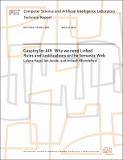Gasping for AIR Why we need Linked Rules and Justifications on the Semantic Web
Author(s)
Kagal, Lalana; Jacobi, Ian; Khandelwal, Ankesh
DownloadMIT-CSAIL-TR-2011-023.pdf (1.178Mb)
Other Contributors
Decentralized Information Group
Advisor
Hal Abelson
Terms of use
Metadata
Show full item recordAbstract
The Semantic Web is a distributed model for publishing, utilizing and extending structured information using Web protocols. One of the main goals of this technology is to automate the retrieval and integration of data and to enable the inference of interesting results. This automation requires logics and rule languages that make inferences, choose courses of action, and answer questions. The openness of the Web, however, leads to several issues including the handling of inconsistencies, integration of diverse information, and the determination of the quality and trustworthiness of the data. AIR is a Semantic Web-based rule language that provides this functionality while focusing on generating and tracking explanations for its inferences and actions as well as conforming to Linked Data principles. AIR supports Linked Rules, which allow rules to be combined, re-used and extended in a manner similar to Linked Data. Additionally, AIR explanations themselves are Semantic Web data so they can be used for further reasoning. In this paper we present an overview of AIR, discuss its potential as a Web rule language by providing examples of how its features can be leveraged for different inference requirements, and describe how justifications are represented and generated.
Date issued
2011-04-16Series/Report no.
MIT-CSAIL-TR-2011-023
Collections
The following license files are associated with this item: